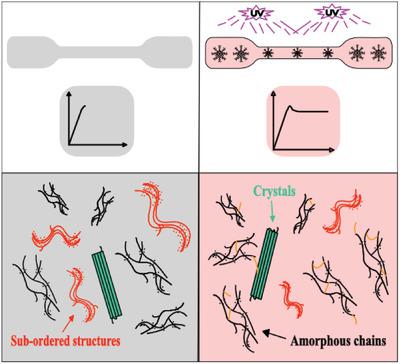当前位置:
X-MOL 学术
›
Macromol. Chem. Phys.
›
论文详情
Our official English website, www.x-mol.net, welcomes your
feedback! (Note: you will need to create a separate account there.)
Physical Aging as the Driving Force for Brittle–Ductile Transition of Polylactic Acid
Macromolecular Chemistry and Physics ( IF 2.5 ) Pub Date : 2020-01-09 , DOI: 10.1002/macp.201900475 Guoqing Zhao 1, 2 , Felipe P. C. Gomes 2 , Heera Marway 2 , Michael R. Thompson 2 , Zhirong Zhu 1
Macromolecular Chemistry and Physics ( IF 2.5 ) Pub Date : 2020-01-09 , DOI: 10.1002/macp.201900475 Guoqing Zhao 1, 2 , Felipe P. C. Gomes 2 , Heera Marway 2 , Michael R. Thompson 2 , Zhirong Zhu 1
Affiliation

|
Polylactic acid (PLA) is an inherently brittle polymer, exhibiting a high Young's modulus and minimal elongation‐at‐break. To transition its failure mode to one that is much more ductile without loss in strength is challenging. A new strategy combining physical aging with ultraviolet (UV) radiation is carried out to reach the desired mechanical properties of PLA. Characterization of the modified resin is done by mechanical, rheological, and acoustic analysis. With the new processing strategy, the elongation‐at‐break of PLA increases from below 5% up to 18% by conditioning at −40 °C for 48 h followed by UV irradiation for 30 h. Correspondingly, results demonstrate that the yield strength and Young's modulus remain statistically unchanged. The interlocked entanglements inhibit the formation and evolution of subordered structures, which are attributed to the gained ductility. The high entanglement density and few subordered structures in the modified polymer system contribute to the unusual elongation‐at‐break without alteration of the modulus.
中文翻译:

物理老化是聚乳酸脆性-韧性转变的驱动力
聚乳酸(PLA)是一种固有的脆性聚合物,表现出高的杨氏模量和最小的断裂伸长率。将其失效模式转变为更具延展性而又不损失强度的模式是具有挑战性的。采取了一种将物理老化与紫外线(UV)辐射相结合的新策略,以达到所需的PLA机械性能。改性树脂的表征是通过机械,流变和声学分析完成的。采用新的加工策略,通过在−40°C下放置48 h,然后进行紫外线照射30 h,PLA的断裂伸长率将从5%以下提高至18%。相应地,结果表明屈服强度和杨氏模量在统计上保持不变。互锁的纠缠抑制了亚有序结构的形成和演化,这归因于获得的延展性。改性聚合物体系中高的缠结密度和少量的有序结构导致不寻常的断裂伸长而不改变模量。
更新日期:2020-01-09
中文翻译:

物理老化是聚乳酸脆性-韧性转变的驱动力
聚乳酸(PLA)是一种固有的脆性聚合物,表现出高的杨氏模量和最小的断裂伸长率。将其失效模式转变为更具延展性而又不损失强度的模式是具有挑战性的。采取了一种将物理老化与紫外线(UV)辐射相结合的新策略,以达到所需的PLA机械性能。改性树脂的表征是通过机械,流变和声学分析完成的。采用新的加工策略,通过在−40°C下放置48 h,然后进行紫外线照射30 h,PLA的断裂伸长率将从5%以下提高至18%。相应地,结果表明屈服强度和杨氏模量在统计上保持不变。互锁的纠缠抑制了亚有序结构的形成和演化,这归因于获得的延展性。改性聚合物体系中高的缠结密度和少量的有序结构导致不寻常的断裂伸长而不改变模量。











































 京公网安备 11010802027423号
京公网安备 11010802027423号